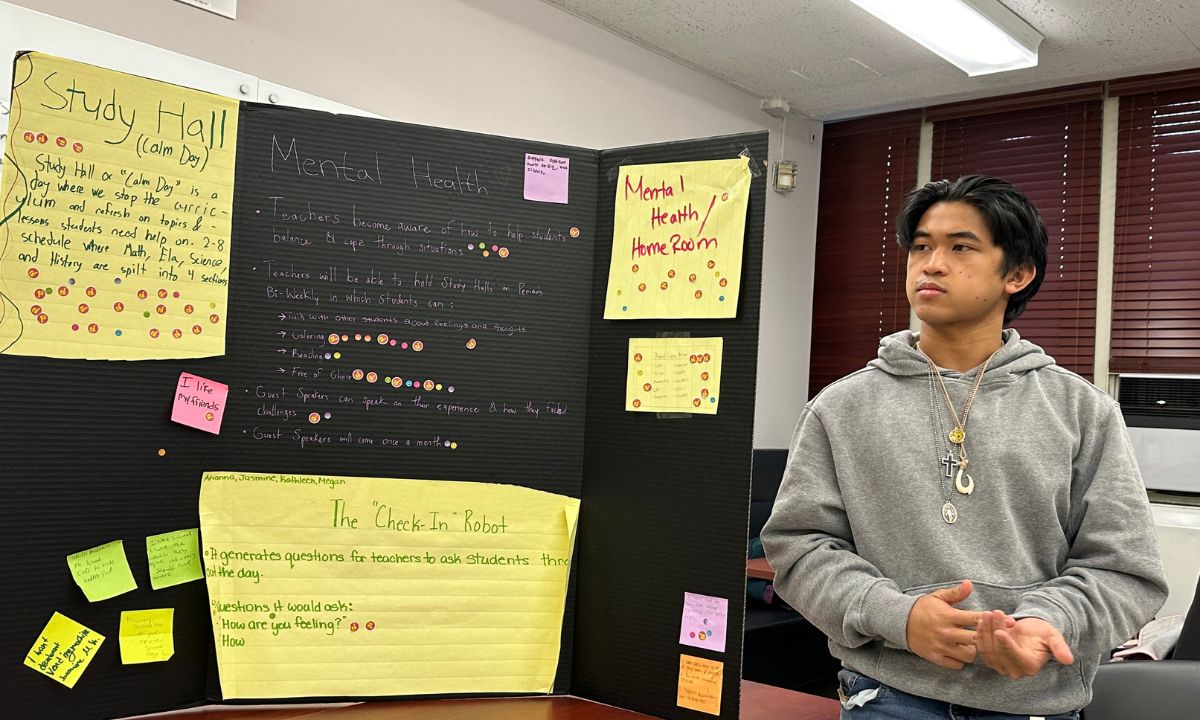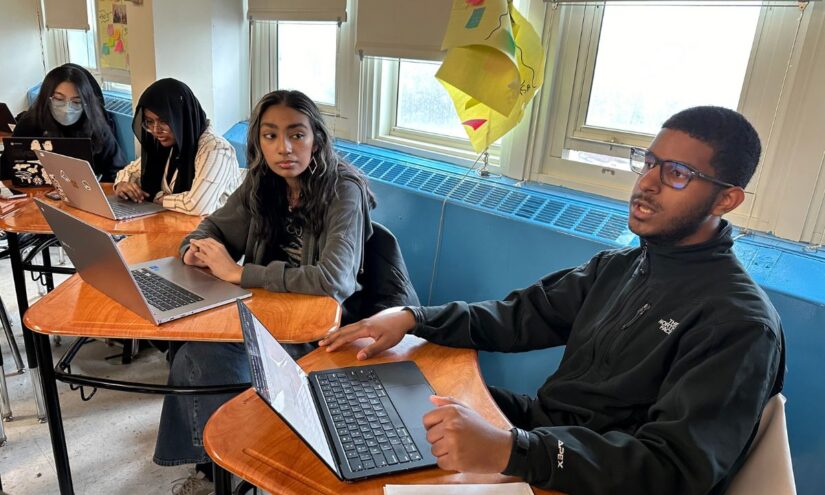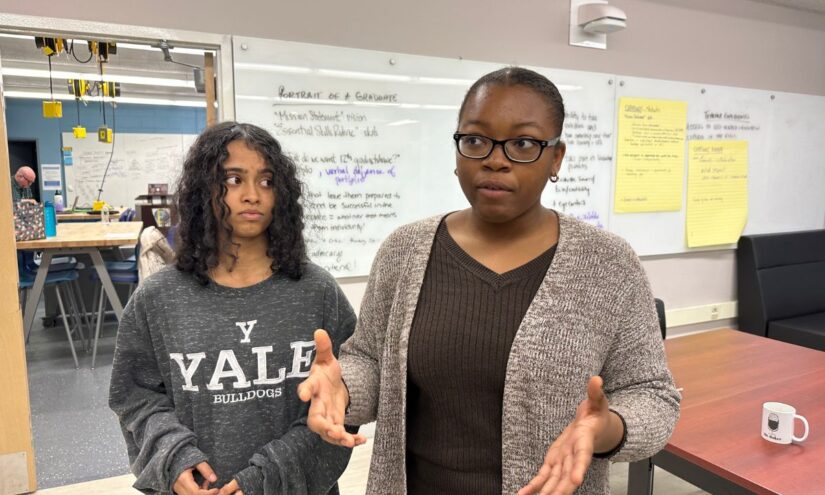NYC High School Reimagines Career & Technical Education for the 21st Century
Thomas A. Edison High School is providing students with the skills to succeed in both college and career in an unusually creative way.

Get stories like these delivered straight to your inbox. Sign up for The 74 Newsletter
At New York City’s Thomas A. Edison CTE High School — a large, comprehensive high school in Queens — students are actively shaping their school’s future. Working alongside teachers, they’re contributing to projects that organically blend career and technical education with college preparation, setting a model for integrating academic content with career-connected learning.
In a recent robotics shop class the teacher was hard to spot among a sea of students working in small teams designing, coding and tinkering with their mechanical creations. Every student had a role, from shop foreman to time manager to cleanup crew. Allyson Ordonez, an 11th-grader, was a class ambassador, welcoming guests and showing them around the classroom.
“Your normal classes — English, math, science — you learn fundamentals, but this class takes those subjects and combines them,” Ordonez said. “Math and science make up robotics and we use everything we learn from these normal academic classes and apply them to what we learn here.”
Ordonez sounded more like a seasoned engineer than a high school student as she showed off a small drone she was building and described the equipment.
Edison attracts teens from all over the city thanks to its 13 career tracks — the most of any New York City public school. Students can earn college credits through a partnership with the City University of New York, take part in internships and work-based learning with companies like Apple and Google, and receive industry certifications. If students pass those industry-recognized exams, they can start working in technical jobs right out of high school — while also pursuing associate’s and bachelor’s degrees.
In some ways, Edison’s offerings are similar to other innovative CTE models across the country that are applying the excitement and engagement of career classes to rigorous academics. But Edison is taking that a step further by giving students tremendous power in its redesign.
Shifting to Career- and College-Readiness
Edison opened in the 1950s as an all-boys trade school. Today, it serves a diverse population of nearly 2,335 students. Principal Moses Ojeda is about as close to an Edison lifer as it gets: he graduated in 1993, later returning as a teacher before becoming an assistant principal and then principal in 2012. He transformed the school from the days of typewriter and copier repair programs to state-of-the-art offerings including robotics, automotive technology, graphic arts and cybersecurity.
All of this stemmed from Ojeda’s early days as principal when a student asked him a question that would change the trajectory of Edison’s teaching.
“We know we’re here for CTE,” Ojeda remembered the student saying. “But why do we need the academics?”
Ojeda asked the student, who was in the automotive track, if he had learned about Pascal’s law in his physics class. “And the kid was like, ‘Yeah, I remember that.’ I said, ‘OK, well, that’s your brake system.’ And I went across the room and made a connection to each academic area.”
Ojeda then turned to social studies teachers Phil Baker and Danielle Ragavanis to help students see the relevance of academic classes to their careers.
“For them, CTE felt useful while academics too often left them wondering, ‘Why are we learning this?’” Baker said.
Ojeda supported Baker and Ragavannis in creating a Research and Development department to engage students in design thinking, including articulating what makes learning meaningful for them. The R&D department has grown to include teachers from every department working with students to figure out how to integrate essential skills into core academic classes. In this way, they’re applying one of the XQ Institute’s crucial Design Principles for innovative high schools: Youth Voice and Choice.
“In order to take on a project, teachers have to partner with one of the kids,” Ragavanis said. “Students are fully at the table, and they have to be our equals, and in some cases, our bosses.”
Edison was later selected for Imagine NYC — a dynamic partnership between New York City Public Schools and XQ to design innovative, high-quality schools with equity and excellence at their core. Faculty members said this collaboration brought additional support and resources to scale their ideas for making the academic courses feel as relevant to students as the CTE classes.
Mastering Essential Skills
Driven by employer demand for “soft skills,” Baker and Ragavanis worked with student designers and teachers in the R&D department to establish “five essential skills”: communication, collaboration, giving and receiving feedback, design thinking and professionalism. These skills reflect XQ’s Learner Outcomes and now guide the learning objectives in many of Edison’s academic classes. Research shows these outcomes, or goals, can help students succeed in college, career and life.
English Language Arts teacher Jason Fischedick, for example, created a student-run community theater, which he called “the most ambitious thing I’ve ever tried to do in the classroom.” Apart from selecting the four student directors, Fischedick ceded almost complete control of the process. Students were responsible for hiring a crew, casting actors and organizing and running rehearsals.
“We’re on a time crunch and we need to figure out how to manage that time effectively to ultimately get a good product to show off,” said 12th grader Colin Zaug, one of the student directors.“It’s all about teaching independence and preparing students for the real world. I don’t know how many of these kids will ultimately be actors, but it teaches time management and how to stay on task.”
Baker said this is how the R&D department is modernizing Edison.
“We’re trying to make a link between academic classes and CTE classes, and bridge the gap that existed between the two, and make sure that academic classes have a career-centered application to them,” he said.

Baker said ninth graders in the R&D department designed the essential skills rubric for their grade so that regardless of what content classes students take, they all get the same immersion into critical career skills. Student voice is now so integrated into Edison’s core that teachers work with student designers to plan their units. And he said teachers are becoming comfortable with the language of career-centered learning and essential skills while students appreciate the engagement and develop a new level of confidence.
Yordani Rodriguez, a 12th-grader, employed the essential skills in a number of leadership positions, from his work on Model UN to serving as editor-in-chief of the school’s literary magazine. And those are abilities that will serve him long after he leaves Edison.
“When you lead somebody and they look to you, you have to be sharp,” Rodriguez said, noting these skills are always in the back of his mind now. “I have to communicate, I have to take feedback and most importantly, I have to be professional.”
Rodriguez will be a first-generation college student when he enters Columbia University in the fall. Baker emphasized, however, that the essential skills will serve students wherever they go next.
“This is the kind of thing that all of our students should be able to use no matter what they do in college or in a career,” he said.
Want to learn more about the latest best practices for innovative teaching and learning? Subscribe to the XQ Xtra, a newsletter that comes out twice a month for high school teachers.
Making Time for Innovation
The R&D Department’s work touches students in every grade. Nearly 40% of 9th graders are involved in classes taught by R&D members, with plans to expand. In addition to essential skills, students also participated in using a project-based approach to learning. Thanks to word of mouth, as well as student showcases to exhibit their work, Baker and Ragavanis have grown their R&D department to include 18 faculty in ELA, math, and science, including new recruit Fischedick.

“They’ve been letting me innovate every year and that’s why I joined this team because I’m someone who likes to try new things,” he said. If something doesn’t work, he added, “That’s OK. I’ve become more open with my classroom and what I can do in the classroom because I feel supported to do so.”
Edison’s lessons are now influencing broader change in New York City high schools. It is an anchor school among the 100-plus city high schools participating in FutureReadyNYC, a bold new vision for career-connected learning.
Edison students are also applying their essential skills off campus. Once a week, a group of them visit PS 175 in Queens. They lead 10-week cycles for students in kindergarten through 5th grade in more than 25 different courses, from cooking to robotics and Model UN.
As with the other opportunities at Edison, Baker said students are getting a much deeper understanding of learning and careers by applying the essential skills outside of the classroom.
“It’s been an incredible experience for our students,” Baker said of the teaching opportunity. “They gain so much in terms of professionalism, confidence, and the ability to explain complicated processes to people, which is a really difficult skill.”
Disclosure: The XQ Institute is a financial supporter of The 74.
Get stories like these delivered straight to your inbox. Sign up for The 74 Newsletter

